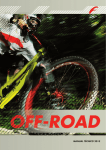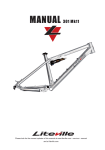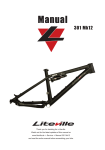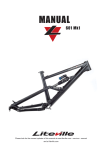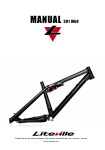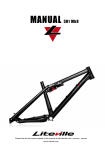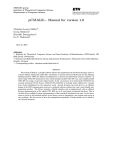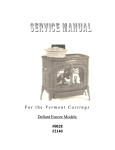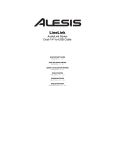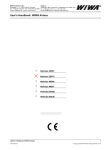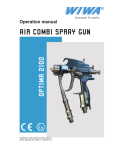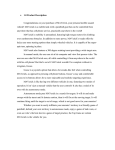Download MANUAL301 Mk11
Transcript
MANUAL 301 Mk11 Thank you for choosing Liteville. Please read this manual before assembling. Please look for the newest updates of this manual at: www.liteville.com > service > manual www.liteville.com > FAQ Limits for the Liteville 301 Frame Please be aware, not all parts available on the market can be used on the Liteville 301 frame and some parts simply should not be used! The following parts have incompatibility restrictions: Suspension fork Only suspension forks with a maximum built height of 565 mm are permitted for use. Check that the fork brace does not contact the head tube when fork is fully compressed. This must be checked for both VarioSpin headset models.Forks we are aware of with restricted compatibility are Fox 32 Talas 26” (all models until 2014 ) Crank / Bottom Bracket Look for clearance Not all available crank/bottom bracket units can be used. The bottom bracket shell uses a BSA thread and 73mm width. Make sure the cranks do not collide with the chain stays and with the SCS chain guide on the right. When using a Shimano front derailleur, ensure it is an E-Type derailleur and a E-Type compatible BB is used. 2 Seatpost The Liteville 301 frame needs a seatpost with a diameter of 34.9 mm. To prevent frame damage, following min. insert length need to be adhered to from MK8 onwards (measured from the end of the seat tube to the top surface of the saddle): up to 200 mm extension length = 120 mm min. insert length over 200 mm extension length = 140 mm min. insert length.The factory black anodised frames have a laser etched mark on the back of the seat tube to indicate this (minimum seatpost insert). This mark indicates the 140mm insert length. Works Finish frames do not have a laser etching. Nevertheless, you need to adhere to the before mentioned requirements. What is the minimum length of a seat post adapter shim? Here, the above mentioned min. insert requirements also apply: up to 200 mm extension length = 120 mm min. insert length over 200 mm extension length = 140 mm min. insert length CAUTION: Despite the use of a seat post shim, you must still adhere to the minimum insert depth of the seat post in the shim! Tip: If you are unsure, choose the longer seatpost shim and double check for compatibility and good quality (such as the Syntace Post Shim Light 31.6 / item no. 113299 and Syntace Post Shim 30.9 / item no. 114203). Wheels/Tires The Liteville 301 compatibility with wheel / tyre size is frame size dependant. Please refer to the Scaled Sizing compatibility recommendation at the end of this manual. When using any other wheel or tyre size check for tyre clearance when frame is fully compressed. Note that as an upper limit when the shock is fully compressed, tha tyre is allowed to contact the seat tube. Please also check the fork manufacturer’s requirements. Note: A brushing of the rear wheel on the seat tube when on full compression when riding will, other than producing a wear mark on the frame, not cause any damage. Seat clamp We recommend the use of our SuperLock2 seatpost clamp. In case you want to use another seatpost clamp, you will need a clamp with a diameter of 38.0mm. Watch specifically for sufficient clearance between seatpost clamp and rear triangle during compression. To test, deflate shock completely and carefully compress the rear entirely Caution: On the Liteville 301 in frame size XS, unlike with all the other frame sizes, the Syntace Superlock2 has to be mounted with the lever facing forward. 3 Shifter cable Only use outer gear casing with 4 mm outside diameter, for example Shimano SIS-SP41. Rear shock / Shock mounts Do not use shocks with an eye-to-eye length other than 200 mm. The shock stroke cannot exceed 57 mm. Tip: The Liteville 301 frame has a special low-ratio suspension design and does not harmonise well with every shock available. The Shocks used in the Liteville 301 have been specifically factory tuned to suit our frames. Hint: A slight brush of the rear wheel at full compression is nothing to worry about. It will damage nothing and may only leave a brush mark on the seat tube. Brakes The Liteville 301 frame has been designed exclusively for use with disc brakes. From Mk8 onwards, the frame comes with 7” PM tabs allowing the use of PM disc brake callipers directly in combination with a 7” rotor without the necessity for an adapter. For the use of rotors > than 7”/180 mm, please contact your respective brake manufacturer. The minimum rear rotor diameter is 180 mm and the maximum diameter is 210 mm. Assembly Frame preparation The contact and bearing contact surfaces (head tube, bottom bracket, drop outs and brake tabs) have already been prepped at the factory and are ready for assembly. Should you still have any assembly issues despite careful frame preparations, please contact Syntace directly. Headset / fork The Syntace VarioSpin headset with 0° bearing cups have been pressed into the frame by the factory. In case you need to change/remove the bearing cups, do not forget to use grease the contact surfaces upon re-assembly. Ensure the bearing cups are pressed in evenly, completely and squarely. When using the VarioSpin tuning bearing cups, ensure the cups are aligned correctly in the frame. Please take note of the respective assembly instructions. Tip: it is best to use a special tool for disassembly and assembly of the bearing cups, such as the VarioSpin assembly tool (item no. 115125) 4 Headangle The Liteville MK11 uses the Syntace VarioSpin headset. Factory fitted are concentrical (0°) bearing cups. By using the Syntace VarioSpin tuning headset (indicated in figure in blue) the headangle can be adjusted +/1.5° to ones personal liking. Headangle -1.5° optional Headangle +1.5° optional Frame size: Art.Nr. XS 114951 S 114944 M 114906 L 114913 XL 114920 XXL 114920 Fork installation Included with the frame are all the headset components required for a tapered (conical / bottom 1.5” – top 1 1/8th) steerer fork. First, install the lower and larger 1.5” of the two slotted rings onto the fork’s steerer tube. The lower slit cone should now be fully fitted on the bearing seat of the fork. Insert the fork into the frame. Slide the smaller slotted 1 1/8th split cone onto the steerer tube from the top and install the black headset cover plate. Note: the reduction kit for 1 1/8th steerer forks is not included with the headset but can be ordered separately (item number: 114593). This will create a different assembly process for the lower half. When using 1 1/8th forks, the lower 1 1/8th reduction shim needs to be assembled between the lower headset split cone and the lower headset bearing (don’t forget to lightly grease all contact surfaces). The assembly of the upper headset half remains the same. Note: when using the Syntace MegaSpacer kit in combination with a Liteville 301 MK11 onwards, a 0.6mm shim is required between the SuperSpin top cap and MegaSpacer. This is included with the Megaspacer (from June 2013) or can be ordered through your Syntace dealer as a spare part. Tip: Do your first test ride without cutting your steerer. You would not be the first to have gotten to it too quickly and cut the steerer too short. 5 SuperSpin tapered unten 1.5, oben 1 1/8 Tip1: Before installing the cover plate, grease upper 1 1/8th bearing. It will help additionally to keep moisture from penetrating to the bearing. Tipp2:Pull the headset tight with the adjustment bolt. Then loosen the bolt again about ¾ of a turn and then do the final tightening of the bolt to set the headset bearing play. This process ensures that all components have set properly. The headset should now spin freely yet still have no play. You may possibly need to do a final re-adjustment during / after first ride. The fork crown should not contact the downtube of the bike when bars are fully turned. Bar / Stem Assemble bar and stem according to manufacturer’s instructions. Shift levers / brake levers Install and adjust controls according to manufacturer’s specifications. Tip: tighten both shift and brake lever with a low torque, such that they can twist on the bars in case of a crash. Bottom bracket / crank & front derailleur Grease both contact surfaces of the E-Type derailleur (where it is clamped between bottom bracket and bottom bracket bearing shell). Fix the Shimano E-Type derailleur with the bolt (supplied by Shimano). Important: Do not use a spacer between frame and derailleur. Tip: Supplied with the frame is a derailleur pad. Attach the pad as in figure to reduce drivetrain noise. Now install both BB bearing cups according to manufacturer’s installation instructions. Don’t forget some grease on the threads. Now tighten the derailleur fixing bolt to manufacturer’s specifications. Install the cranks to manufacturer’s specifications. As described on page 2. ensure there is enough room for rotation between crank arms and chain stays, or SCS chainguide if used on the drive side chainstay. 6 Installing cables on the down tube You can mount the rear shifter cable and the rear brake line on top of the cable pads with cable holders to achieve an optimal routing. We recommend the installation of the cable as shown here to the left around the head tube. This routing reduces rubbing of cables on the head tube and ensures the bars can be turned freely. Cable routing for front derailleur Before you can install the front derailleur cable housing, you need to unbolt the front shock mount and carefully fold down the shock. To mount the cable housing, you will find special mounts on the bottom side of the top tube. Proceed as follows:Sharply bend a zip tie about 10 – 15 mm behind the tip so get something close to a hook. Now insert the hooked zip tie into the cable mount. Make sure you insert only far enough so the tip snaps over the little cross ridge. By pulling and pushing, you can direct the zip tie all the way through until the head is at the top tube. Now you can ins¬tall the cable housing (and the optional cable housing for an adjustable seat post. Note: only pull the zip tie tight by hand! 7 Cut the zip tie right at the head (using a precision cutter) and turn the heads all the way to the top tube so they do not stick out. The shift cable runs between top tube and shock. Let the shifter cable exit through left rear shock mount and seat tube brace. The shifter housing for the front derailleur should neither run in a large arch nor in a very “direct” way to ensure good function. Cable routing for the rear derailleur The shifter cable for the rear derailleur is routed in a direct manner through the seat tube into the chain stay. To protect the cable even better from corrosion, we use an additional, flexible black tube. Hint: Do not remove the transparent plastic tube. In case you did remove it, reinstall it by pushing it thorough¬ly into its seat (blue in the diagram) and do NOT use lubrication (such as a silicone spray). The exit for the shifter cable is at the lower rear end of the right chain stay. 8 The exit for the shifter cable is at the lower rear end of the right chain stay. Changing a shifter cable housing Leave the black tube in place. Cut the new cable housing with a 45° cut as shown. Spray a little silicone spray into the guide tube. Insert shift cable from the front until it reaches the right chainstay at the chainstay yoke.Use the rest of the shift cable housing as a handle by rolling it up. Let the housing find its way by turning and pushing at the same time. Tip: It will work even easier if the rear triangle is moved up and down by about 1 – 2cm. To do this remove the shock at the front shock mount. Push the cable housing further through the right chainstay, until the housing hits the exit. Let the cable end find its way through the hole by turning and and at the same time pushing. To finish, cut the cable to length. Done. Alternative method Cut off the head of an old shift cable. Insert the old shift cable without casing through the plastic tube and through the chain stay until it exits at the other end of the chainstay. Guide the cable housing onto the old shift cable and guide back through the frame. By turning and pushing of the outer housing let the housing end find its way through the chainstay and through the plastic tube until it appears from the exit in the seat tube. To finish off, remove old shift cable and cut outer housing to length. Done. Note: The outer housing for the rear derailleur and the brake lines are attached to the downtube by cable holders. Please only tighten the cable holder bolts with low torque – they are only there to stop the cables from moving around. If these bolts are over tightened, they will crimp the outer housing and brake line which can compromise function. 9 Routing of brake line Be aware that the brake line shortens during compression of the frame. Leave it long enough! Use the included clips for mounting the brake line on the left chain stay. If you use zip ties, ensure they are only lightly pulled tight such that the brake line can still move when the rear is compressed. If zip ties are done up too tight, they can create unwanted noises. Caution: The routing pictured is for brake callipers where you can turn the line towards the rear. It will vary with other brake models. Rear derailleurs Install and adjust the rear derailleur according to manufacturer’s instructions. Rear derailleurs from Shimano Only use rear derailleurs with shadow technology. Use of older rear derailleurs with the large housing loop is not recommended on Liteville 301 frames from Mk8 on. These rear derailleurs do not harmonize well with the new, low-profile routing into the chainstay. Rear derailleurs from SRAM SRAM XX1, X01, XX, X0, X9, X7. Reasons for preference of Shimano shadow and SRAM derailleurs: • Direct cable routing without unnecessary tight bends • Reduced friction by avoiding tight radii • No bashing of derailleur against chain stay, chain movement is minimised • Reduced likelihood of a stick getting caught • Reduced noise and wear Attention: For perfect protection, install the optional Syntace RockGuard III. There are different models for SRAM, Shimano Shadow and Saint models. 10 Tip: There is a sticker included for the front derailleur. Install it as pictured to reduce chain slap at the front derailleur. Seat tube / seatpost / saddle Check the inside of the seat tube for edges and burrs before you insert the seatpost. If necessary, remove with fine sand paper (such as grit 180) before inserting the seat post. Take note of min. insert length as described on page 2. Attention: If fully inserted, the seat post may reach the “dent” for the front derailleur. If you try to force it any deeper, you may damage seat post and/or frame. Tip: Cut the seatpost to the “minimum insert” length after being sure that you have found the correct height. Also don’t forget that the soles of different shoes varies in thickness and that saddles may vary in build height. That way you can lower the seat post to the max. Attention: Take note of the seatpost’s wear limit. When frequently adjusting the height of your seatpost in muddy or dusty conditions, material wear actually takes place on the surface of both the seat tube and seatpost. The wear on carbon seatposts is much higher than on alloy seatposts due to the coated resin matrix/fibers used. To keep this wear to a minimum, we re¬commended removing the seatpost from the frame after every ride in wet/muddy conditions and then to clean it. The inside of the seat tube should also be cleaned with a rag at this occasion. Check the diameter of the seatpost from time to time. At no position along the post, the diameter is allowed to become less than 34.7mm! If this is the case, the seatpost requires replacing to prevent the frame from being crushed resulting in possible deformation or cracking in the clamping area. Now assemble the saddle according to seatpost and saddle manufacturer’s instructions. 11 Syntace X-12 trough axle The Syntace X-12 through axle system is the only axle system available which allows the adjustment of toe and camber. The 5mm Allen key bolt in the right drop out serves only for attachment of the derailleur hanger and to clamp the thread insert. This bolt does not need to be opened when undoing the X-12 axle! Note: The threaded insert is adjusted to suit your specific frame. The exact positioning with the 0.5 mm and 1.0mm inserts is when the mark is located at the clamping slit. Suspension setup Air pressure For optimal performance, it is advisable to adjust the Liteville 301 precisely. Proceed as follows: • Get on your Liteville 301 with full equipment (backpack, helmet etc.) and start riding. • Look down onto the sag indicator “Dynamic Level” and check the position of the two indicator pins. Attention:: We strongly discourage you from feeling the position of the sag indicators with your fingers as you may severely crush your fingers. • • If the two pins do not point at each other, adjust air volume in the shock. Either add or remove air. • Our recommendation is pin-to-pin. • How to adjust the shock “harder” or “softer” can be seen in the following figure. 12 Dynamic Level adjustments: Soft: Max. pin above frame pin Our recommendation: pin-to-pin Hard: Max. pin below frame pin Adjustment of rebound • Ride at medium speed off a curb. The chassis should only bounce once. • If the rebound is too fast (chassis bounces more than once), close the rebound circuit a bit. Most shock manufacturers indicate this by “+” or a “turtle”. The adjustment dial is usually red in colour. Please be aware: the rear end should not rebound too slowly either or else the suspension will “pack up” after riding over several obstacles in quick succession. If necessary adjust. Most manufacturers indicate this direction with a “-“ or a “rabbit”. Please observe installation instructions and manual from the manufacturer of the shock. Build-in interfaces 13 Adjustable seatpost with remote The Liteville 301 Mk11 has been prepared for installation of an internally routed height adjustable seatpost with remote actuation. The entry to the seat tube can be found on the left lower end of the seat tube. Assemble the seat post remote cable according to seatpost manufacturer’s manual. You can also use a dropper post with external remote routing. To use such a post, you will find an elongated hole in the top of the top tube just in front of the seat tube (Figure 1.) and one elongated hole in the bottom of the top tube and near the headtube (Figure 2.). Figure 1 Figure 2 Syntace SCS Chain Guide Integrated tabs for the patented Syntace SCS chain guide are standard on the 301 from MK8 onwards. The tab can be found on the outer right hand surface of the right hand chainstay next to the chainstay yoke. The Syntace SCS chain guide offers low weight and an unknown precision coupled with reliability for double and triple chainring setups. RockGuard derailleur protector Integrated attachment point for the Syntace Rockguard derailleur protector. Caution: Due to changing derailleurs and derailleur hangers, RockGuard type I and type II will no longer fit from 301 MK 11 (Jan 2014) onwards. Instead of hassle with misaligned derailleur hangers and soft bent derailleur hangers … strong, reliable function 365 days of the year. 14 Enclosed are two different derailleur hangers. Shimano direct mount Standard derailleur hanger Shimano Shadow and SRAM Maintenance and care Bearings frame / VarioSpin headset All bearings used are greased for life and do not need to be disassembled to be repacked with grease. In case of a defective bearing you can order a new bearing from your Liteville dealer or from Syntace direct. Tip: When cleaning, do not let a strong jet of water contact the bearings (see section “washing”). Too much assumed “care” can reduce the bearing life considerably. Bolts All frame bolts used are high-tensile strength titanium or aluminium bolts. They have been manufactured specifically for our Liteville frames. They have been assembled by the factory using a thread locker. However, you should still regularly, and especially after first assembly, check all frame bolts to check they are still tight as per max. torque rating (see page 18). Black anodised frames have the max. torque lasered next to the bolt location. In case of loss or damage you can order them through your Liteville WerkStation or from Syntace directly. Before replacing any bolts, ensure you have applied the correct thread locker (see page 18) and that it can cure for the correct length of time. Attention: Look carefully! Should a bolt really move when checking to see if bolts are tightened to specification, then the thread locker bond will be broken and the bolt will need to be newly assembled. Clean the old thread locker off the bolt and reassemble with new thread locker (see page 18). You will find more detailed thread locker information on www.liteville.de -> FAQ. Hint on creaking noises: Sometimes one needs to do the opposite of what one expects…for example, if it creaks up front, grease in the rear. The suspected creaking from the bottom bracket might not be caused there at all. You will find more detailed information on www.liteville.de -> FAQ. 15 Washing Never use a high-pressure washer or strong water stream from your garden hose or similar to clean your frame! The strong water stream can force water into the bearings and premature corrosion and wear can follow. Dirt, blown away by high water pressure, will scratch the surface and mark it permanently. Clean the frame only with water from a bucket or with a soft stream from a water hose and use, if necessary a soft brush or sponge. The main cleaning process is best done with a soft sponger, a bucket of warm water and a few drops of dish washing liquid. Rub the frame dry so that no water marks remain on the frames surface. To achieve a nice sheen, use silicone spray and wipe with a soft cloth. Caution: Do under no circumstances get the silicone spray onto the brake rotors / brakes. You will loose the brake’s functionality and will require new pads. Just the spray carried through the air can be enough to cause this. Works Finish Additionally to the finish Race Black anodised and the powder coating colours we also offer a limited number (limited edition) of frames of every frame series in a Works Finish. The Liteville works finish is a real “raw” aluminium surface finish without any additional treatment. It is no raw colour imitation of a metallic surface. It displays the natural irregular surface structure of our craftsmanship. Changes over time such as darkening in tone and formation of darker areas are mandatory with this finish. It is this, which creates the natural charm of the patina of a real works finish aluminium surface. By the way, this surface can be reworked either mechanically or chemically. You can scotch-brite the surface, you can polish it matt or to a mirror finish or even coat it as desired. The Works finish frames are accompanied by two rough Scotch Brite pads. Test the achievable finish in a hidden spot such as on the underside of the frame. Liteville logo on the Works Finish frame We accompany the “nude” frames with two decals cut out of 3M individual letters. You can decide for yourself whether you want to apply these or not. Travel identification: 16 By looking at the position of the sag meter (Dynamic Level) you can determine which travel works finish rocker links you have: 140 mm Lever 160 mm Lever 17 18 10-20 Nm X-12 Achse FAQ. 10 Nm 10 Nm 10Nm 6 Nm 10 Nm 6 Nm more detailed thread locker information on www.liteville.de -> 10 Nm reassemble with new thread locker (see page 18). You will find newly assembled. Clean the old thread locker off the bolt and thread locker bond will be broken and the bolt will need to be checking to see if bolts are tightened to specification, then the Attention: Look carefully! Should a bolt really move when tighten any bolts. Always use a torque wrench such as the Syntace Torque Tool to 1 Nm Leicht anlegen 15 Nm 30 Nm insert 20 Nm screw 15 Nm 10 Nm 10 Nm Bolts: Maximum torques and thread locker green = heavy duty thread lock blue = medium duty thread lock white = without thread lock 19 riding. Horst Link Lager Hinteres Wippenlager Schwingen-Hauptlager Gleit-/Nadellager in Dämpferaugen Oberrohrlager (see section “washing”). Too much assumed “care” can reduce the bearing life by more than 20 000km of that no loctite flows into the bearing seal. When cleaning, do not let a strong jet of water enter the bearings cotton bud apply the loctite bearing race and frame bearing seat sparingly. Please pay special attention so Syntace Bond 48 Hochfest). To do this, degrease the bearing seat with a cleaning alcohol. Then, using a If replaced, the highlighted bearings must be assembled using a high strength loctite (for eg. Loctite, Bearings with Loctite green = heavy duty thread lock blue = medium duty thread lock white = without thread lock 20 21 Your Notes: 22 Your Notes: 23 Syntace GmbH Am Mühlbach 5C D - 87487 Wiggensbach Tel. +49 (0)8370 929988 Fax +49 (0)8370 929888 [email protected] Sales for Germany, Austria and Switzerland: Syntace GmbH Dammweg 1 D - 83342 Tacherting Tel. +49 (0)8634 66666 Fax +49 (0)8634 6365 [email protected] Current: 11.04.2014 24
























